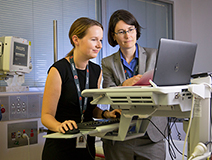Medical scribes could help doctors care for more patients
31/01/2019

A new role in the health system could improve efficiency in emergency departments and decrease the time patients spend in emergency departments, following a successful trial in hospitals throughout Victoria recently published in The BMJ.
Scribes are trained to complete clerical data entry associated with a patient’s visit to the emergency department, allowing doctors to concentrate on core medical tasks instead.
In the first trial of its kind in Australia, locally-trained scribes were used in five hospital emergency departments across the state of Victoria, Australia – Cabrini Malvern, Dandenong Hospital, Austin Hospital, Bendigo Hospital and Monash Children’s Hospital. Scribes were present during the time when a patient consults with a doctor and assisted in writing up patient notes, in close consultation with the treating doctor.
Scribes are used in hospitals throughout America and have been trialled in other countries internationally but are not operational in Australia.
Currently, Australian emergency department doctors spend nearly 50 per cent of their time typing up patient notes and undertaking other clerical tasks, taking their focus away from core medical tasks like seeing patients, working out what is wrong with them and communicating this to patients and their health team.
The research looked at data from 589 scribed shifts (5098 patients) and 3296 non-scribed shifts (23,838 patients), and compared how productive they were.
Results from the trial, led by Cabrini’s Alan, Ada and Eva Selwyn Emergency Department (ED) doctor Associate Professor Katie Walker, found that scribes increased the efficiency of emergency departments and decreased doctors’ administrative workload.
“Traditionally, a doctor’s role has been focused on patient care but since the introduction of electronic health records, we have become increasingly overloaded with documentation and clerical responsibilities that take us away from our primary duty of care for our patients,” A/Prof Walker said.
“This program has been designed to reduce the administrative workload for physicians and increase the time spent treating patients.”
A/Prof Walker said the use of scribes in emergency departments improved the productivity of emergency doctors and decreased the time spent in the emergency department for patients.
“With the assistance of scribes, doctors were able to treat 25 per cent more patients per shift, which has significant economic and social benefits,” she said.
“Our research showed benefits at all of our participating sites, decreasing the total time patients needed to spend in the emergency department by 19 minutes”.
“Patients were unaffected by the presence of scribes and our research showed the majority of patients were unperturbed about having them in consultations. In addition, 85 per cent of doctors said they preferred to work with scribes and other medical staff in the emergency department were unaffected.”
Results from the trial showed the program could provide cost benefits for emergency departments through the 19-minute efficiency saving by increased revenue from additional patients or time-based performance improvements. The research found scribes could save hospitals up to US$31.15 (AUD$43.48) per scribed hour.
A/Prof Walker said she hoped the research would persuade hospitals to employ scribes in Australia to support emergency physicians by enabling them to safely see more patients. She hoped the research would generate interest in developing international trials of the program in emergency medicine as well as local trials of the program in other medical disciplines.
“Ideally, I would like to see scribes as a fundamental part of medicine worldwide,” she said.
The trial was supported by senior researchers from the Cabrini Institute, Monash University and the Emergency Medicine Events Registry (EMER)(Australasian College for Emergency Medicine, Australian Patient Safety Foundation).
The trial was funded by the Cabrini Foundation; the Phyllis Connor Memorial Trust, managed by Equity Trustees; and by Equity Trustees as managers of the Ella and Michael Brazier Fund, the Charles Lamond Forrest Estate, the Louisa Henty Estate, the Charles and Jessie Strong Trust, the Theodotus John Summer Charitable Trust and the Charles Frederick William Taylor Estate.
Authors: Katherine Walker, Michael Ben-Meir, William Dunlop, Rachel Rosler, Adam West, Gabrielle O’Connor, Thomas Chan, Diana Badcock, Mark Putland, Kim Hansen, Carmel Crock, Danny Liew, David Taylor, Margaret Staples.
Links:
- Title: Impact of scribes on emergency medicine doctors’ productivity and patient throughput: multicentre randomised trial. Published in The British Medical Journal (BMJ): https://www.bmj.com/content/364/bmj.l121
- Author Blog – Dr Katie Walker and Dr Michael Ben-Meir: https://blogs.bmj.com/bmj/2019/01/30/its-time-to-think-hard-about-how-clinicians-work-in-a-digital-age/
- Cabrini Emergency Medicine Research Department